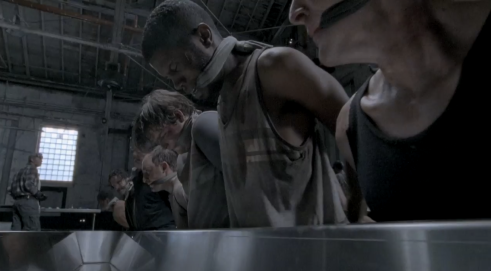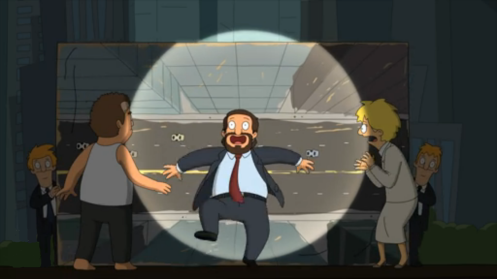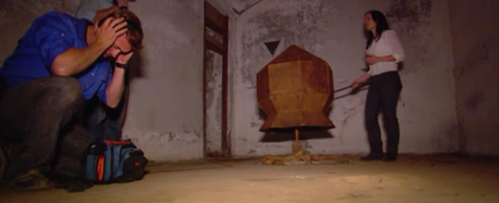
Bridesmaids is the latest Judd Apatow-produced heartwarming variety of comedy film, and the first one to be led by an all-star female cast. I want to establish right out that my opinions of this film, positive or negative, were (hopefully) not influenced by the fact that this film happened to primarily star women and be written from their perspective. Due to a poor advertising campaign, and ultimately, a poor film culture when it comes to movies about women (especially comedies), men (and women too!) may go into this expecting to see the characters getting into catty fights, gushing over wedding gowns, and falling madly in love with mysterious foreign men. Don’t get me wrong – this film has all these things, but at the end of the day, Bridesmaids is a film about friendship, which is something we (hopefully) can all relate to, regardless of sex/gender.
In Bridesmaids, Kristen Wiig stars as Annie, a down-on-her-luck cynic who attempts to hold onto the one positive, constant element of her hectic life – her lifelong friendship with Lilian, played by her one time SNL co-star Maya Rudolph. Lilian asks her to be the maid of honor in her upcoming wedding – a task which ultimately leads to the further unraveling of Annie’s sanity, often with humorous results.
The cast was generally fantastic in this movie, although I think the group of bridesmaids could have been pared down a bit without effecting almost anything. It seemed strange to me that, considering Annie and Lilian had been friends since childhood, Annie only meets the rest of the bridesmaids at the engagement party. These introductions are so brief, that I never really knew who The Office’s Ellie Kemper and Reno 911’s Wendi McLendon-Covey were supposed to be, and their characters never really do much besides play within their usual character types (Ellie Kemper as the innocent, naive type, and Wendi McLendon-Covey as the sex-obsessed bad girl) in a couple of funny scenes which don’t affect the plot whatsoever.
Even Maya Rudolph’s character is almost completely undefined, but I suppose I can let it slide that in a movie called Bridesmaids, the bride herself doesn’t play as big a role as her bridesmaids. Other than that, the key characters in this film are Annie, her rich and too-perfect antagonist Helen (played by Rose Byrne, with just the right level of naivety as to the damage of her actions), the socially crude sister of the groom Megan (Melissa McCarthy, who stole absolutely every scene she was in), and Annie’s main love interest, Officer Rhodes, played by Chris O’Dowd – star of the brilliant British TV comedy The IT Crowd – who I was definitely happy to see in a mainstream American film like this.
The writing and acting in Bridesmaids was often laugh-out-loud funny, and managed to cater to fans of all varieties of humor: whether you like crude language and poop jokes, find yourself chuckling at awkward situations, or take pleasure in the absurd and unbelievable, there is something here for you. To be honest though, I almost wish they hadn’t tried to aim for such a broad audience, as it often feels like the work of a huge team of writers, rather than a focused comedic effort. Still, I cannot deny that it was definitely funny, and it was interesting to see which parts made different audience members laugh harder than others.
One of the most underwhelming things about this movie was the pacing of Annie’s character arc. For about the first hour and a half of the film, Annie falls deeper and deeper into despair, violating everyone around her as she does so. Then suddenly, she receives a pep talk from a somewhat unlikely person, and not only pulls herself together, but fixes just about everyone’s lives in the last twenty minutes. Overall, I felt her character arc (actually, she was really the only character that changed much at all) was handled a bit sloppily, and unfortunately it brought the film down a bit as a result.
I felt the ending itself was pretty weak, as I hoped to see at least a short epilogue after the wedding to show how the characters’ lives and relationships had ultimately been affected by the events of the movie, though I suppose it’s not too hard to figure this out on your own. I guess it just felt abrupt to me.
Overall, I’d say that as a comedy, Bridesmaids delivered laughs, which I suppose makes it a success. However, I’d have to disagree with anyone that feels this movie has reinvented the wheel, especially if they think so because it stars an ensemble cast of women. In this day and age, giving a movie like this such a huge pat on the back, just because it features women making fart jokes, is extremely patronizing. Although I suppose it is a good thing that a female ensemble comedy is getting as much attention as it is, it almost feels like a back-handed compliment. “Good job, girls! You can be funny! Here’s a pat on the head!”
I felt this movie would not have been nearly as talked-about if it had starred men. Don’t get me wrong, it is not bad at all, and is leagues better than any other comedy playing theaters right now, but I just felt it was “good-enough (for comedy, not for women),” rather than “great.” I hope with all my heart that this movie (despite not being terribly groundbreaking in my eyes) will open the door for other better female-led comedies, and films in general for that matter. I also hope we see a lot more from all the cast members of Bridesmaids, especially Melissa McCarthy and Kristen Wiig.
All in all, it was a fun ride, and is worth at least a matinée ticket. Just try not to get too caught up in the hype, whether from the apologetic perspective that it is funnier than most “chick flicks” (shudder), or from the overly-defensive perspective either. 3.5/5.









